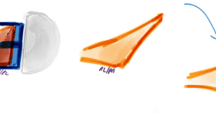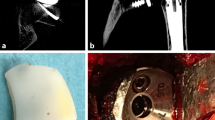Abstract
Background
Although TSA has been shown to significantly yield better outcomes than hemiarthroplasty, glenoid prosthesis loosening remains the most common complication. Inadequate primary fixation enables the glenoid component to move. In primary glenohumeral osteoarthritis (GHOA), glenoid involvement and proper morphology vary considerably. Postero-inferior glenoid hypoplasia could be associated with some degree of osteoarthritis. According to Walch, 24 % of glenoids in GHOA are type B2 or C (excessive posterior retroversion), which increases the challenge for the glenoid component fixation.
Materials and methods
A total of 30 cases of TSR with glenoid type B2 (20 cases) and type C (10 cases) were reviewed. Mean follow-up was 11.2 months. A metal-backed (MB) glenoid component was implanted, with a posterior bone graft reconstruction. Pre- and post-operative clinical evaluation was done using the Constant–Murley score and the SST from Matsen.
Results
There is no glenoid loosening, no joint narrowing and no radiolucent line. There was no bone graft osteolysis. With 4 patients revised (4 conversions from TSR to RSR for 3 instabilities and 1 secondary rotator cuff tear), on the overall 30 patients cohort, Constant score pain increased from 1.6 to 13.4, forward flexion from 92° to 146° and Constant score from 27 (36 %) to 70 (95 %). The statistical difference between pre- and post-operative values is greatly significant.
Conclusion
Although MB prostheses have been noted to have a higher rate of loosening than full-cemented PE, this is not our experience, even in case of glenoid type B2 or C, where the technical challenge is demanding and most of the time a posterior bone graft is necessary.



Similar content being viewed by others
References
Matsen FA, Franklin JL, Barret WP, Jackins SE (1988) Glenoid loosening in total shoulder arthroplasty: association with rotator cuff deficiency. J Arthroplasty 3:39
Matsen FA III, Lippitt SB (2004) Principles of glenoid arthroplasty. In: Matsen FA III, Lippitt SB, DeBartolo SE (eds) Shoulder surgery: principles and procedures. Saunders, Philadelphia, pp 508
Iannotti JP, Spencer EE, Winter U, Deffenbaugh D, Williams GR (2005) Prosthetic positioning in total shoulder arthroplasty. J Shoulder Elbow Surg 14:111S–121S. doi:10.1016/j.jse.2004.09.026
Nyffeler RW, Sheikh R, Atkinson TS, Jacob HAC, Favre P, Gerber C (2006) Effects of glenoid component version on humeral head displacement and joint reaction forces: an experimental study. J Shoulder Elbow Surg 15:625–629. doi:10.1016/j.jse.2005.09.016
Walch G, Badet R, Boulahia A, Khoury A (1999) Morphologic study of the glenoid in primary glenohumeral osteoarthritis. J Arthroplasty 14:756–760
Churchill RS, Brems JJ, Kotschi H (2001) Glenoid size, inclination, and version: an anatomic study. J Shoulder Elbow Surg 10:327–332
Codsi MJ, Bennetts C, Gordiev K, Boeck DM, Kwon YW, Brems JJ et al (2008) Normal glenoid vault anatomy and validation of a novel glenoid implant shape. J Shoulder Elbow Surg 17:471–478. doi:10.1016/j.jse.2007.08.010
Ganapathi AM, McCarron JA, Chen X, Iannotti JP (2011) Predicting normal glenoid version from the pathologic scapula: a comparison of four methods in 2D and 3D models. J Shoulder Elbow Surg 20:234–244. doi:10.1016/j.jse.2010.05.024
Kwon YW, Powell KA, Yum JK, Brems JJ, Iannotti JP (2005) Use of three dimensional computed-tomography for the analysis of the glenoid anatomy. J Shoulder Elbow Surg 14:85–90. doi:10.1016/j.jse.2004.04.011
Neer CS II (1974) Replacement arthroplasty for gleno-humeral osteoarthritis. J Bone Joint Surg Am 56:1
Neer CS II, Morrison DS (1988) Glenoid bone-grafting in total shoulder arthroplasty. J Bone Joint Surg Am 70:1154–1162
Friedman RJ, Hawthorne KB, Genez BM (1992) The use of computerized tomography in the measurement of glenoid version. J Bone Joint Surg Am 74:1032
Mullaji AB, Beddow FH, Lamp GHR (1994) CT measurement of glenoid erosion arthritis. J Bone Joint Surg Br 76:384
Edelson JG (1995) Localized glenoid hypoplasia: an anatomy variation of possible clinical significance. Clin Orthop 321:189
Jain NB, Higgins LD, Guller U, Pietrobon R, Katz JN (2006) Trends in the epidemiology of total shoulder arthroplasty in the United States from 1990–2000. Arthritis Rheum 55:591–597. doi:10.1002/art.22102
Radnay CS, Setter KJ, Chambers L, Levine WN, Bigliani LU, Ahmad CS (2007) Total shoulder replacement compared with humeral head replacement for the treatment of primary glenohumeral osteoarthritis: a systematic review. J Shoulder Elbow Surg 16:396–402
Cofield RH, Edgerton BC (1990) Total shoulder arthroplasty: complications and revision surgery. Instr Course Lect 39:449–462
Deshmukh AV, Koris M, Zurakowski D, Thornhill TS (2005) Total shoulder arthroplasty: long-term survivorship, functional outcome, and quality of life. J Shoulder Elbow Surg 14:471–479. doi:10.1016/j.jse.2005.02.009
Franta AK, Lenters TR, Mounce D, Neradilek B, Matsen FA III (2007) The complex characteristics of 282 unsatisfactory shoulder arthroplasties. J Shoulder Elbow Surg 16:555–562. doi:10.1016/j.jse.2006.11.004
Matsen FA III, Clinton J, Lynch J, Bertelsen A, Richardson ML (2008) Current concepts review. Glenoid component failure in total shoulder arthroplasty. J Bone Joint Surg Am 90:885–896. doi:10.2106/JBJS.G.01263
Mansat P, Briot J, Mansat M, Swider P (2007) Evaluation of the glenoid implant survival using a biomechanical finite element analysis: influence of the implant design, bone properties, and loading location. J Shoulder Elbow Surg 16(3Suppl):S79–S83
Collins D, Tencer A, Sidles J, Matsen F III (1992) Edge displacement and deformation of glenoid components in response to eccentric loading. The effect of preparation of the glenoid bone. J Bone Joint Surg Am 74:501–507
Dines JS, Fealy S, Strauss EJ, Allen A, Craig EV, Warren RF, Dines DM (2006) Outcomes analysis of revision total shoulder replacement. J Bone Joint Surg Am 88:1494–1500
Iannotti JP, Clay Greeson C, Downing D, Sabesan V, Bryan JA (2012) Effect of glenoid deformity on glenoid component placement in primary shoulder arthroplasty. J Shoulder Elbow Surg 21:48–55. doi:10.1016/j.jse.2011.02.011
Lazarus MD, Jensen KL, Southworth C, Matsen FA 3rd (2002) The radiographic evaluation of keeled and pegged glenoid component insertion. J Bone Joint Surg Am 84:1174–1182
Rodosky MW, Bigliani LU (1994) Surgical treatment of non-constrained glenoid component failure. Oper Tech Orthop 4:226–236
Rice RS, Sperling JW, Miletti J, Schleck C, Cofield RH (2008) Augmented glenoid component for bone deficiency in shoulder arthroplasty. Clin Orthop Relat Res 466:579–583. doi:10.1007/s11999-007-0104-4
Scalise JJ, Iannotti JP (2008) Bone grafting severe glenoid defects in revision shoulder arthroplasty. Clin Orthop Relat Res 466:139–145. doi:10.1007/s11999-007-0065-7
Hill JM, Norris TR (2001) Long-term results of total shoulder arthroplasty following bone grafting of the glenoid. J Bone Joint Surg Am 83:877–883
Steinmann SP, Cofield RH (2000) Bone grafting for glenoid deficiency in total shoulder replacement. J Shoulder Elbow Surg 9:361–367. doi:10.1067/mse.2000.106921
Conflict of interest
The author is “Arrow shoulder prosthesis” designer.
Author information
Authors and Affiliations
Corresponding author
Rights and permissions
About this article
Cite this article
Kany, J., Katz, D. How to deal with glenoid type B2 or C? How to prevent mistakes in implantation of glenoid component?. Eur J Orthop Surg Traumatol 23, 379–385 (2013). https://doi.org/10.1007/s00590-012-1118-5
Received:
Accepted:
Published:
Issue Date:
DOI: https://doi.org/10.1007/s00590-012-1118-5




